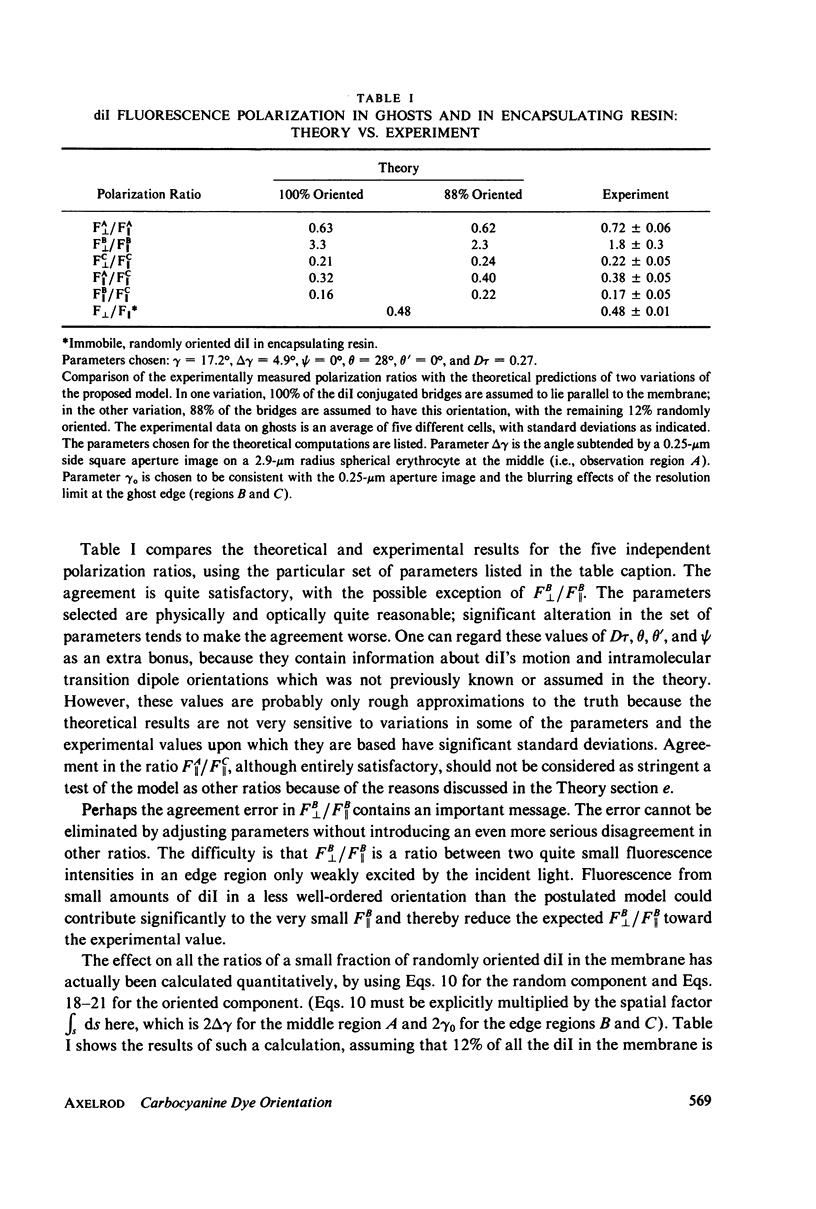Abstract
The orientation of an amphipathic, long acyl chain fluorescent carbocyanine dye [diI-C18-(3)] in a biological membrane is examined by steady-state fluorescence polarization microscopy on portions of single erythrocyte ghosts. The thermodynamically plausible orientation model most consistent with the experimental data is one in which the diI-C18-(3) conjugated bridge chromophore is parallel to the surface of the cell and the acyl chains are imbedded in the bilayer parallel to the phospholipid acyl chains. Comparison of the predictions of this model with the experimental data yields information on the intramolecular orientations of the dye's transition dipoles and on the dye's rate of rotation in the membrane around an axis normal to the membrane. To interpret the experimental data, formulae are derived to account for the effect of high aperture observation on fluorescence polarization ratios. These formulae are generally applicable to any high aperture polarization studied on microscopic samples, such as portions of single cells.
Full text
PDF
















Images in this article
Selected References
These references are in PubMed. This may not be the complete list of references from this article.
- Axelrod D., Wight A., Webb W., Horwitz A. Influence of membrane lipids on acetylcholine receptor and lipid probe diffusion in cultured myotube membrane. Biochemistry. 1978 Aug 22;17(17):3604–3609. doi: 10.1021/bi00610a029. [DOI] [PubMed] [Google Scholar]
- Badley R. A., Martin W. G., Schneider H. Dynamic behavior of fluorescent probes in lipid bilayer model membranes. Biochemistry. 1973 Jan 16;12(2):268–275. doi: 10.1021/bi00726a015. [DOI] [PubMed] [Google Scholar]
- Johnson M., Edidin M. Lateral diffusion in plasma membrane of mouse egg is restricted after fertilisation. Nature. 1978 Mar 30;272(5652):448–450. doi: 10.1038/272448a0. [DOI] [PubMed] [Google Scholar]
- Pagano R. E., Weinstein J. N. Interactions of liposomes with mammalian cells. Annu Rev Biophys Bioeng. 1978;7:435–468. doi: 10.1146/annurev.bb.07.060178.002251. [DOI] [PubMed] [Google Scholar]
- Peters R., Peters J., Tews K. H., Bähr W. A microfluorimetric study of translational diffusion in erythrocyte membranes. Biochim Biophys Acta. 1974 Nov 15;367(3):282–294. doi: 10.1016/0005-2736(74)90085-6. [DOI] [PubMed] [Google Scholar]
- Schlessinger J., Axelrod D., Koppel D. E., Webb W. W., Elson E. L. Lateral transport of a lipid probe and labeled proteins on a cell membrane. Science. 1977 Jan 21;195(4275):307–309. doi: 10.1126/science.556653. [DOI] [PubMed] [Google Scholar]
- Sims P. J., Waggoner A. S., Wang C. H., Hoffman J. F. Studies on the mechanism by which cyanine dyes measure membrane potential in red blood cells and phosphatidylcholine vesicles. Biochemistry. 1974 Jul 30;13(16):3315–3330. doi: 10.1021/bi00713a022. [DOI] [PubMed] [Google Scholar]
- Waggoner A. S., Wang C. H., Tolles R. L. Mechanism of potential-dependent light absorption changes of lipid bilayer membranes in the presence of cyanine and oxonol dyes. J Membr Biol. 1977 May 6;33(1-2):109–140. doi: 10.1007/BF01869513. [DOI] [PubMed] [Google Scholar]
- Yguerabide J., Stryer L. Fluorescence spectroscopy of an oriented model membrane. Proc Natl Acad Sci U S A. 1971 Jun;68(6):1217–1221. doi: 10.1073/pnas.68.6.1217. [DOI] [PMC free article] [PubMed] [Google Scholar]



